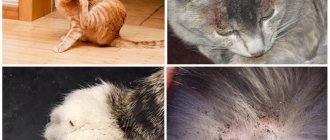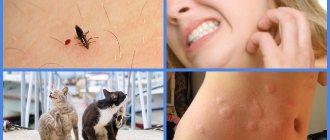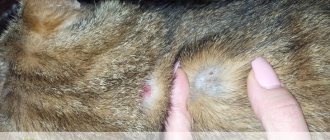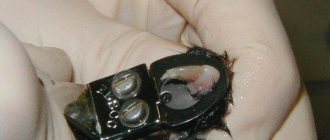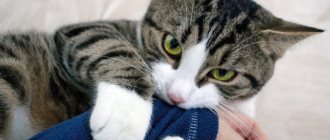Not a single cat is immune from the appearance of fleas, even those that have never been outside the apartment. Fleas not only cause pain to pets, but can also infect them with serious diseases. Fortunately, fleas on a cat are not forever; there are effective ways to get rid of parasites using industrial preparations, as well as to remove fleas with home remedies. Home remedies do not work very quickly, but they are not toxic and are suitable for almost all animals - from pregnant cats to small kittens.
Distinctive features of cat fleas
Cat fleas are one of the most common types of fleas. However, despite their name, they affect not only cats, but also dogs, as well as humans. Cat fleas are carriers of many dangerous diseases, and therefore it is necessary to know their distinctive features.
External difference from other types of fleas
Cat fleas are related parasites of rat and dog fleas. At the same time, they have a number of external features:
- brown or black shiny color;
- body size from 0.5 to 2 mm;
- wings are missing;
- long hind limbs that allow the flea to jump up to half a meter.
The cat flea is a small, but very nimble and dangerous insect.
These small insects move very quickly, hide deep in the animal’s fur, closer to the skin, so it is practically impossible to notice them on the fur. The flea's body has a strong shape elongated in height and laterally compressed, which allows it to move deftly in the fur, jump high and protect itself from simple mechanical compression. It is much easier to notice the insect on a person due to the lack of fur, but it is also difficult to catch and destroy.
Methods and reasons for the appearance of fleas in animals and in the house
Even careful care of your pet does not guarantee the absence of fleas. Often cat owners are surprised where their pet got annoying parasites if the domestic cat doesn’t even leave the house.
There are several ways to become infected with cat fleas:
- through other pets;
- through street clothes and shoes;
- through the entrance of a residential building;
- through basements, cracks, neighboring rooms;
- through rodents (eg rats and mice).
The highest probability of infection occurs in the autumn-summer period. A favorable breeding environment for fleas is dampness, lack of ventilation, and clutter. Most often, private houses and apartments on the first floors are susceptible to flea attacks. Insect larvae and eggs can be found in the most hidden places: baseboards, cracks in the floor, carpets, furniture, clothes, cat bed. Bloodsuckers reproduce very quickly, and therefore it is important to promptly detect their appearance and begin the fight.
The first signs of fleas in a cat are quite difficult to identify, since they do not appear in any way, except for a little more frequent scratching. However, as the number of attacking individuals increases, you may notice a change in the pet’s behavior - the appearance of severe anxiety due to constant itching. Scratched bite spots form on the skin, small black dots can be found on the stomach, in serious cases, hair may begin to fall out, abscesses and allergic dermatitis may form.
Danger to animals and humans
The appearance of cat fleas on a pet is fraught with infection with infectious diseases, including those fatal to the cat. Fungal, skin diseases, worms, and in children the development of anemia, developmental delay, even death, are the consequences of untimely destruction of parasites.
Cat fleas will not bypass you and your household. In humans, exposed areas of the body are most often attacked - legs, arms, back, stomach. In addition to the unpleasant itching, a flea bite is dangerous for humans due to the possibility of transmitting diseases such as typhus, encephalitis, salmonellosis, plague, worms and other diseases.
Cat fleas pose a threat to humans
Although humans are not the preferred target for cat fleas, if they appear on a pet, there is a high probability that the insect will not miss a large and easily accessible flea such as a person. A flea appears on a human body only during a bite, unlike an animal, in whose fur the parasites can even lay eggs.
Therefore, it is very important to start the fight against bloodsuckers in time.
What does a flea look like?
If you look at a flea under a microscope, this blood-sucking insect looks like a scary monster. The flat body, 1.5 to 4 mm long (1), is attached to paws covered with spikes for easy movement through the fur. The hind legs are especially powerful - after all, this helps the flea to jump as much as half a meter in length (this is like a person jumping 200 m). On the small head of the flea there is an oral cavity that is capable of biting through the rather tough fur of the animal. A real monster, you say. And you'll be right.
Although, due to their small size, fleas seem to be inconspicuous and harmless insects, in fact this small midge is about 3 millimeters in length, but is capable of bringing truly hellish torment to its owner. So if you notice small brown insects with a flat body in your cat’s fur, gathering in groups near the ears (the skin is softer there), then these are undoubtedly fleas.
Methods for removing fleas from a cat
There is quite a wide variety of methods and means of getting rid of fleas. But most often the most effective is a set of measures, especially if the number of insects is high. To completely destroy the larvae and eggs, it is possible to use special chemicals, which must be used only in accordance with the instructions for them in order to protect yourself and your pet.
Fighting methods - comprehensive instructions
To fight effectively, it is necessary to develop a clear action plan, including the following methods:
- First of all, it is necessary to understand the reason for the appearance of cat fleas (infection through an animal or possible penetration of fleas into the room through cracks, basements, etc.);
- Remove parasites from your pet and protect it from re-infection;
- Seal gaps, joints, cracks in doorways, floors, baseboards. If you have a basement and suspect the presence of fleas there, contact a specialized service for treatment;
- Carry out a wet general cleaning of the room, vacuuming, ventilating, cleaning pillows and blankets;
- Choosing a suitable means to control insects in the house (chemical or folk). When processing a room, it is important to remember the following rules:
- a product must be chosen that can destroy not only adults, but also larvae and eggs;
- treatment must be carried out in all rooms using a continuous method (larvae can hide in the most secluded places, especially damp and warm, and therefore the bathroom must also be treated);
- it is necessary to follow the instructions for keeping the room after treatment (treated non-working and non-contact surfaces should not be subjected to wet cleaning during the period of action of the drug);
- Carrying out preventive measures to protect the premises and animals from re-infection.
Means of struggle
The following flea remedies for cats are available:
- Shampoos are a fairly harmless product; there are special ones for babies and mothers. The main difficulty lies in application, since not all cats are calm about water procedures. However, the resulting effect is worth the effort;
- drops - applied to the skin in the withers area, suitable for both cats sitting at home and those who like to go for a walk. It is necessary to follow the instructions for use (cannot always be used for kittens and nursing cats);
- collars are impregnated with insecticides, the main disadvantage is that irritation on the neck from the strap may occur; it is also not recommended for free-roaming cats to use it, so as not to accidentally get the collar caught on something and not be able to get out; it is not advisable to use it for sick cats, kittens and mothers ;
- sprays - sprayed onto the cat's fur, has a fast-acting effect, the main condition is not to get on the mucous membranes and not allow the cat to lick the fur until the product is completely absorbed, limitation - cannot be used for babies and nursing cats;
- tablets are a fairly effective remedy if you can get your pet to eat the drug, since many people categorically refuse medications in tablet form.
A large selection of flea remedies allows you to both get rid of parasites and protect against their further appearance.
Many people prefer to use folk remedies, due to the fact that they are less toxic and are suitable for most cats:
- wormwood - boil in boiling water, apply the resulting cooled broth to the cat’s skin, repeat treatment as necessary;
- essential oils are a safe product; cedar, lavender, geranium, and mint are good; 2-3 drops per 3 glasses of water are enough to spray an animal; you can add them to shampoo;
- salt - prepare a solution at the rate of 50 g per 1 liter of water, so that you can immerse the animal in it up to the neck, hold for 5 minutes and then rinse with warm water;
- tar soap - immerse a bar of soap in water and foam, rub the cat’s fur with the resulting solution, leave for 5 minutes, then rinse with plenty of water, the remaining smell from the soap will additionally protect against the appearance of fleas.
Folk remedies for fleas are safe for sick, pregnant cats and kittens
General information about fleas
Fleas (Siphonaptera) are an order of blood-sucking insects. Currently, entomologists have described 2086 species. They are found everywhere (found even in Antarctica), but are most widespread in countries with temperate and subtropical climates (East and Central Asia, Western America, East Africa). There are 524 species of parasites living in Russia.
When a flea settles on the body of birds and mammals, it begins to actively reproduce and constantly bite through the skin to gain access to the blood, which it feeds on. This causes severe discomfort (itching) in the owner.
The peculiarity of fleas is that different species have some differences in the structure of the oral apparatus and the composition of the enzymes responsible for processing the blood absorbed by the insect. That is why they are divided depending on which hosts they prefer to settle on. Fleas of the species Ctenocephalides felis choose cats as a source of food.
The cat flea Ctenocephalides felis is very small, its body size is from 0.75 to 5 mm
cat flea
The insects Ctenocephalides felis have a number of features. For example, the cat flea is an expert in jumping and the ability to carry weights. It has been proven that this type of parasite can easily pull a load that will exceed their own weight by 130 times. And they jump to a height that exceeds their height by 150 times.
Fleas are not used to fasting - their feeding schedule is 10–15 times a day; without access to blood, the parasite can survive for a maximum of two days
One can also envy the endurance of the insect. For example, it easily makes more than 3,000 jumps in a row. The flea is not afraid of temperature tests. In severe frosts (more than -20 °C), it goes into suspended animation (when the metabolism slows down and the insect essentially falls asleep). “Freezing” can last more than a year. When warming occurs, the parasite “thaws out” and calmly goes in search of a source of food in the form of a warm-blooded animal.
The flea owes its jumping ability to the structure of its hind legs - they are powerful and long
Morphology
The body of the flea Ctenocephalides felis is pear-shaped, slightly flattened on the sides, and covered with numerous hard hairs. The head is small (no more than 1/10 of the entire body). It has three pairs of limbs: 4 front legs are shortened, and the hind legs - jumping - are long. The jaws are powerful and easily bite through the skin of an adult cat. To prevent the blood from clotting, the flea injects saliva into the wound, which causes itching and swelling in the animal at the site of the bite.
Fleas have developed stiletto-shaped jaws, which allow them to quickly bite through the skin of mammals.
Lifestyle
For adult fleas, the only source of food is the blood of mammals. Sucking lasts from 1 to 5 minutes. The insect needs to eat frequently (about every hour), therefore, having eaten, it does not jump off the cat’s body, but remains in the animal’s fur.
If you don't take action, several hundred fleas can live on one cat.
Reproduction
It is difficult to rid cats of fleas, as the parasites are incredibly fast. They also reproduce very actively. The female can begin to lay eggs on the 1st or 2nd day after contact with the animal’s body. How many descendants she can leave behind depends on her life expectancy. On average, one individual lays 500–800 eggs (one clutch can range from 10 to 50 eggs).
The cat flea lays eggs directly in the fur of cats, or jumps onto the floor and attaches the eggs to the fibers of the carpets
Life cycle
Under optimal conditions for the insect (temperature from +18 to +24 °C and humidity more than 60%), approximately 10–50 days pass from the egg stage to maturity. A legless, worm-like larva crawls out of the egg, which does not yet feed on fresh blood and does not bite the cat - it eats the feces of adult fleas and pieces of blood caked on the surface of the wounds. The larva then goes through three molting stages and develops into an adult parasite.
The average lifespan of one cat flea is 1.5–2 years
Removing fleas from kittens
Fleas pose a danger to cats and people, but the consequences are especially dire for kittens. Bites can cause babies to develop anemia, which can be fatal.
The most dangerous consequences of flea bites are for newborn kittens.
Infection most often occurs from mother cats, but the affected area and the number of attacking individuals in kittens are much higher. Accordingly, the process of removing parasites is much more complicated, since it is impossible to use chemicals on cubs.
The safest way is to comb from the scruff of the neck along the back, belly and paws. You can also use folk remedies: a decoction of wormwood for bathing or laying out dry branches in the cat’s habitat; tar soap, the foam of which is rubbed into the kitten’s fur; bathing in a weak saline solution.
There are also special flea shampoos for kittens. However, before use, you must consult your veterinarian and carefully follow the instructions.
For babies older than six months, you can use essential oils, collars and special insecticides, but those marked are allowed for kittens. In any case, when choosing a product, it is better to consult a specialist.
Symptoms of flea infestation
To check your cat for fleas, you need to part its fur and examine its skin. Flea bites appear as patches of redness with a black dot in the center. The animal itches frequently, prolonging the healing time of wounds. Since parasites prefer to bite a cat in the abdomen and neck, these areas of the body should be examined especially carefully.
Also a sign of invasion is a white sticky coating on the hairs. These are secretions from the digestive system of insects. And the white grains, similar to salt crystals, stuck to the fur, are flea eggs.
To assess the condition of a cat when diagnosing a parasitic infestation, pay attention to the following symptoms:
- frequent licking of the coat;
- deterioration of appetite and sleep;
- weakness, apathy;
- causeless aggression.
Signs of the presence of parasites are flea excrement on the animal's fur.
Treatment of a pregnant and lactating cat
The choice of methods for getting rid of fleas in a pregnant and lactating cat, as well as in kittens, must be approached very carefully. To do this, you must follow the following rules:
- Be sure to consult a veterinarian;
- wash, or better yet, boil the bedding on which the cat sleeps;
- clean and disinfect the premises.
It is acceptable to use gentle and low-toxic drugs: shampoos, collars and drops.
The less toxic the flea remedy, the safer it is for the expectant or new mother.
However, it is necessary to remember that the stress of bathing is harmful for mothers and if your cat does not like water, then it is better to choose another remedy. Collars and shampoos do not penetrate the skin and do not have a toxic effect on the fetus, unlike drops, and therefore consultation with a specialist is required before using them. For nursing cats, collars are not always a suitable option, as kittens may lick them while crawling on their mother.
Therefore, the best option for anti-flea remedies may be folk remedies, and simply combing out the pet’s fur.
How to recognize an infection
The presence of fleas in your cat can be recognized by the following characteristic symptoms:
- skin itching - the cat constantly itches and bites into the fur;
- marks of bites (red pimples) and scratches on the animal’s body;
- small black grains - flea excrement, which are found if you part a cat's fur;
- the presence of the insects themselves - when there are a lot of parasites and they become fattened, they can easily be seen on the pet’s skin;
- white peas firmly attached to the hairs - flea eggs, they can only be noticed when closely examining the fur.
In advanced cases, when there are a lot of fleas, the cat's fur becomes thinner, he becomes weaker from constant itching, loses his appetite, suffers from insomnia, and loses weight. In place of constantly scratched wounds, fistulas or abscesses and allergic dermatitis can form.
If a cat has fleas, then when combing it, black grains (parasite excrement) will fall onto the floor and the insects themselves will jump out
Room treatment
In the fight against parasites, room treatment plays an important role, since fleas are on the victim only at the time of the bite, but they can live and lay eggs in any secluded places.
First of all, it is necessary to thoroughly clean the apartment: vacuum, including upholstered furniture, and wet clean all hard-to-reach places using tar soap, soda, and vinegar. Bedding, soft toys, and cat litter must be washed; for this, you can prepare decoctions of wormwood, lavender, or tansy. After wet cleaning, surfaces can be rinsed with water with the addition of essential oils.
Carpets and rugs must be vacuumed, if possible, knocked out on the street, and also treated with a special anti-flea preparation. It is also possible to disinfect upholstery and carpeting using a steam generator. As a rule, one treatment with a vacuum cleaner or steam generator will not be enough; the procedure must be repeated within a week or two. High-pile carpets are treated with special sprays (Dichlorvos, Raptor, Reid and others), and then thoroughly cleaned. When processing the spray, it is better not to just spray it on the carpet, but to rub it into the pile using rubber gloves. After treating the carpet surface, at least a day should pass before the carpet is cleaned. You can clean the carpet using a brush with a soapy solution with the addition of soda.
Even if fleas appeared in the house through an animal and they were successfully removed, cleaning and disinsection of the premises is a prerequisite
After preliminary cleaning, it is necessary to treat the room with insecticidal agents. When choosing flea products, it is recommended to be guided by the following requirements for them: effectiveness, ease of use, absence of stains on furniture after treatment, speed, presence of various active ingredients.
Basic means for processing an apartment can be grouped as follows:
- aerosols are the most popular means, as they do not require additional preparation during processing and cover a large area of the room when sprayed (Raptor, Dichlorvos, Raid, Combat);
- powders - scatter in the habitats of fleas in the apartment, but it is necessary to exclude the possibility of access to these places by animals and children (Peretrum, Domovoy, Fenaxin, Clean House and others);
- Concentrates for preparing a solution are economical, since a large volume of solution can be obtained from one tube after dilution, but they are more suitable for disinfestation by specialists, since to be effective, it is necessary to properly dilute the concentrate and use special protective agents (Chlorpyrimac, Get, Biorin).
The choice of a product for treating fleas at home is an individual matter, especially since there are a lot of options. In case of severe infestation, it may be necessary to use a set of measures that includes several anti-flea products. The main thing to remember is that you must use chemicals strictly in accordance with the attached instructions, protecting yourself, children and animals as much as possible from possible contact of the substance with the mucous membranes and inside the body.
Can fleas from a cat spread to humans?
Cat fleas will not be able to bite through human skin, so they will not choose us for permanent residence. But they can try to feast on human blood - after biting a couple of times and making sure that the person is not suitable for them to feed on, they will immediately jump off. It seems harmless, but these small bites will itch, swelling and redness will occur.
Inflamed “bumps” on the skin and itching are signs of an allergic reaction to insect saliva
What is the biggest danger of cat fleas?
Flea bites cause severe itching. Scratching damaged areas of the body leads to infections entering the wound, causing it to become inflamed and fester. The biggest danger is that parasites are carriers of encephalitis, plague, typhus, salmonellosis, tularemia and more than 25 other deadly diseases.
Fleas can carry not only infections, but also worm eggs.
Preventive measures
After ridding the animal and housing of fleas, the main question arises - how to prevent re-infestation. Unfortunately, there is a possibility of insects being introduced due to reasons beyond our control. However, there are a number of measures that, if observed, will help minimize the risk of reappearance of parasites:
- maintain order in the house, clean, wash and shake out cat litter;
- with the beginning of the spring-summer season, protect your pet from fleas using special means (collars, drops, sprays, etc.);
- try to limit your cat’s contact with infected animals.
Such very simple methods can save you and your ward from a lot of hassle in the fight against fleas. After all, it is much easier to prevent a threat than to deal with its consequences.
How to eliminate the consequences of bites
The main task of a person who has seen a flea bite on himself or his pet is to prevent scratching the wound. To do this, you need to eliminate the symptoms - itching, inflammation. Simple folk remedies help. If signs of complications appear, it is important to promptly begin treatment using medications (including anti-inflammatory and anti-infective creams).
How to relieve itching and pain
The first thing to do is to disinfect the bite with iodine, alcohol or antibacterial soap. This will help prevent the spread of infection.
The next task is to relieve the itching. The easiest way is to apply a piece of ice or gauze soaked in cold water to the bite site. This will stop the urge to scratch for a few minutes. A longer lasting effect is achieved by using hydrocortisone cream or antipruritic drugs (Fenistil gel, Psilobalm). Can be used:
- tea tree oil;
- strong tea leaves;
- chamomile decoction.
You need to soak a cotton swab in the liquid and apply it to the itchy area of the body.
If you have treated your cat with some kind of cream or oil, do not forget to put a collar on the animal that prevents the product from being licked off.
Allergic reaction
Insect allergy (an acute reaction to enzymes from insect saliva) is treated with antihistamines. In case of local swelling or skin rash, it is better to use creams and gels. If a reaction occurs in the form of fever, nausea, vomiting, you should take an antiallergic drug orally (in the form of tablets, drops) or give an injection.
For severe reactions to bites in people, topical corticosteroids (Methylprednisolone aceponate, Mometasone furoate, etc.) are prescribed. In very severe cases of allergies to flea bites, Prednisol is taken (course no more than 3 days).
Advantan - an ointment based on methylprednisolone aceponate - is used for severe allergic reactions to flea bites
Flea allergies in cats are also treated with antihistamines. Since the animal tends to lick off creams or wipe them on the floor and furniture, it is preferable to administer medications through injections - for example, give injections of Dexamethasone, Flumethasone, Methylprednisolone, Betamethasone, etc.
Treatment of dermatophiliasis
Due to repeated scratching of one place, dermatophiliasis occurs - a secondary infection, accompanied by the appearance of pustules (pustules) or ulcers. For treatment, wounds are treated with a 1–2% solution of menthol or salicylic alcohol (3–4 times a day). The patient is given antibiotics:
- Amoxiclav;
If dermatophiliasis develops, the patient is prescribed antibiotics, such as Amoxiclav
- Coamoxiclav;
- Trimethoprim.
The doctor should select the remedy depending on the stage and form of dermatophiliasis and its complications. It is important to note that this therapy is suitable for both people and cats - the only difference is in the dosage of the drugs.
What is the danger of parasitic insects?
No one is protected from fleas. For an innumerable number of these parasites to appear in your apartment, it is enough to bring in one such bloodsucker. At the same time, it is not at all necessary that the pet come into contact with a flea-bearing animal. A flea can “arrive” on your shoes or on the paws of any pet.
Fleas carry a large number of diseases that pose a threat to both cats and people. We can highlight the main and most common health problems that can arise from these insects:
- Allergic reactions. Some cats are allergic to flea saliva. In this case, the animal will itch even more. And if the allergen is not eliminated in time, then such proximity in some cases leads to hair loss and the formation of scabs on the cat’s body.
- Worms. Fleas carry the eggs of parasites such as pinworms, roundworms, and flukes. While licking its fur, the cat swallows a considerable number of these eggs. And in kittens and weakened animals, helminthic infestation in some cases leads to death.
- Anemia. In advanced situations, long-term coexistence of an animal with fleas leads to anemia in the pet (decreased hemoglobin in the blood).
Human contact with fleas is dangerous because these insects can be carriers of serious diseases. One bite of such parasites can infect a person:
- worms;
- salmonellosis (acute intestinal infection of animals and humans caused by salmonella);
- encephalitis (an inflammatory process affecting the brain);
- typhoid (an infectious disease accompanied by mental disorders against the background of severe fever and intoxication);
- tularemia (an acute infection that affects the lymph nodes, skin, lungs, and sometimes the mucous membranes of the eyes and pharynx);
- brucellosis (a dangerous infection that affects all systems of the body).
One flea bite can lead to many diseases
Where do fleas come from?
Some owners of pet cats are confident that a pet that does not come into contact with street animals cannot become infected with fleas. But this is a fundamentally erroneous opinion, since transmission from one animal to another is only one way of infection. And parasites, like their larvae, can be found on grass, soil, trees and other objects near which a cat walks.
If a pet goes for street walks, then the probability of infection is almost 100%. The likelihood also increases if there is a dog or other animals in the house.
But even if the animal does not go for walks and stays exclusively within the house, there are many options for infection. For residents of the first floors of apartment buildings, the problem of infection is especially pressing. Many houses have basements where stray animals or rats live, which are carriers of fleas. The latter, in search of new food, can go to nearby apartments and even get to the second or third floors.
But even in apartments located on the upper floors, in the complete absence of walks and contact with other animals, a domestic cat has every chance of becoming infected:
through street shoes or clothing of family members (flea larvae are usually transmitted this way, but adults can also be carried); during an accidental exit into the entrance, especially considering the jumping ability of fleas and their ability to move long distances; when visiting a veterinary clinic, since homeless infected animals are often brought here; in the case of participation in competitions or exhibitions, where the risk of infection increases several times, since the owners of participating animals may not pay due attention to anti-parasitic treatment, and some may not even suspect infection; when visiting guests who also have pets infected with parasites; when traveling on public transport: even when using a special carrier, fleas can get inside through holes in the body.
The eggs of parasites land on various objects in the house, where they mature over time, and the adults immediately look for a host. For a certain time, it can become a person who, sooner or later, will convey them to the pet.
Collar
Special repellent collars are saturated with an odor that fleas cannot tolerate, i.e. the product repels (but does not destroy insects). The collar is a porous tape, the material of which retains the smell of the substance applied to it well. This can be either a natural repellent - essential oil, which is safe for cats' health, or a small dose of a synthetic insecticide. For kittens and pregnant cats, collars with natural repellents should be used.
Experts recommend using collars as a preventative measure after the cat’s fleas have already been removed using more powerful insecticidal preparations, or used as a means of complex therapy (i.e. drops + collar). Repellent collars repel not only fleas, but also lice, scabies and ixodid ticks.
The effect of the flea collar lasts up to 8 months. It is very simple to use: just fasten the collar around the cat’s neck and trim off the excess. Do not remove it until the active substance wears off. There is a small “minus”: the fur under the collar cakes, and this is not suitable for cats that take part in exhibitions and competitions.
Collars popular with cat owners: “Bars” (AVZ), “Doctor Zoo”, “Bolfo” (Germany).
If a cat has scratches on its neck, you cannot use a collar; the active substance applied to it can get into the wound and cause a serious allergic reaction in the animal. You can put on a flea collar for cats only after the skin has completely healed.
So let's get acquainted
Cat flea. A very small insect. Sizes from 0.5 mm to 3 mm. She cannot fly because she has no wings.
But it has very strong hind legs, with the help of which it can jump from one object to another. Each individual has its own owner, in this case a cat, never changes owner and lives with him throughout its life.
However, this does not stop her from “feasting” on others. Cat fleas are brown in color. The body is flattened as if it were squeezed from both sides. The shell is very hard.
Dog flea. It has slightly larger dimensions, up to 5 mm. The mouthparts are piercing-sucking. Has 6 legs. The body shell is inferior in strength to that of a cat. But in order to crush it you will have to make considerable efforts.
Otherwise they are similar to each other.
Effective flea control
One of the most popular remedies against fleas and other blood-sucking insects in cats is drops called “Bars”, which combines a very reasonable price and high quality. These drops can be used on kittens from 2.5 months and adult cats. Watch the dosage! This is very important due to the increased sensitivity of cats to permethrin, which is the active ingredient of the drug. A single use of Barsa relieves the animal of fleas and ticks for a period of one to two months.
Preventing the appearance of fleas in the apartment
However, the fight against fleas is not limited to their one-time extermination. There is always the possibility of them getting into an apartment or house again. Also, in multi-storey buildings, warm basements are often the habitat of fleas. If there are a significant number of cat fleas in the basement, you should contact the sanitary and epidemiological station, otherwise the fight against them in the apartment may not bring any results.
To prevent the proliferation of fleas in an apartment, it is necessary to carry out thorough periodic cleaning of places where they may accumulate. Rugs and bedding also need to be washed periodically using insecticidal agents.
It is best to wear an anti-flea collar on your pet - this way the parasites will avoid the cat. Periodically, you should carefully examine the animal for the presence of fleas and, if they appear, immediately take measures to destroy them and disinfect the apartment. You should also be careful when coming into contact with other animals.
Prevention
Preventing a disease is easier than treating it. If you avoid infection, you do not need to choose drugs to treat your cat.
Preventive anti-flea measures include:
- Preventing contact between indoor cats and outdoor cats.
- Wet cleaning of the apartment with the addition of insecticides to the water - at least once a month.
- Steam treatment of cat accessories: bedding, sleeping baskets, litter tray.
It is also important to wash your hands when you come home from the street, and keep your clothes and shoes clean. The rules are simple, but following them helps to avoid problems associated with a cat becoming infected with blood-sucking insects.


